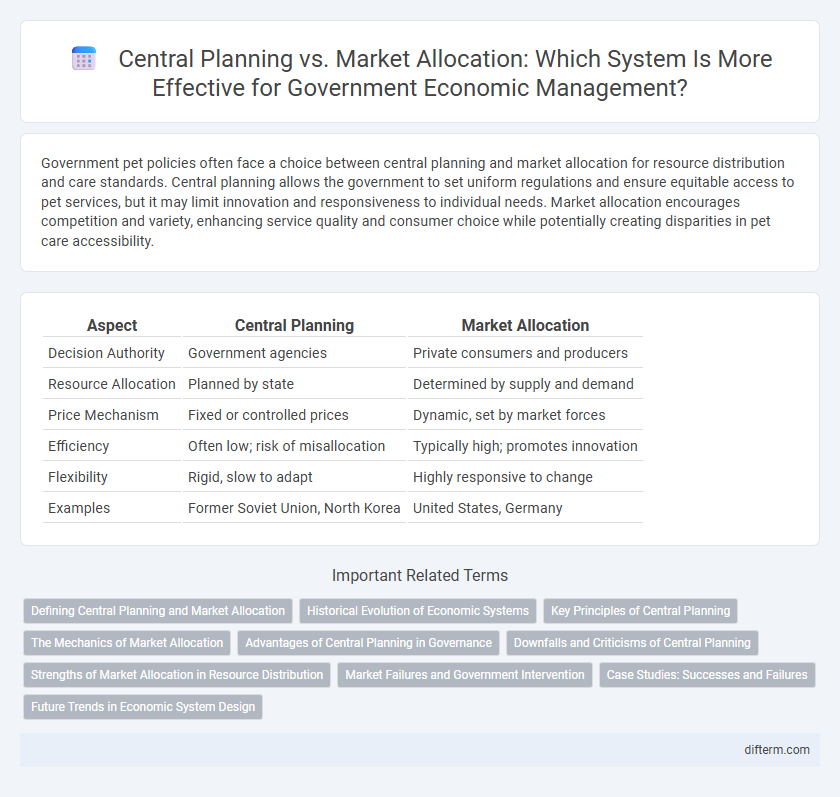Government pet policies often face a choice between central planning and market allocation for resource distribution and care standards. Central planning allows the government to set uniform regulations and ensure equitable access to pet services, but it may limit innovation and responsiveness to individual needs. Market allocation encourages competition and variety, enhancing service quality and consumer choice while potentially creating disparities in pet care accessibility.
Table of Comparison
| Aspect | Central Planning | Market Allocation |
|---|---|---|
| Decision Authority | Government agencies | Private consumers and producers |
| Resource Allocation | Planned by state | Determined by supply and demand |
| Price Mechanism | Fixed or controlled prices | Dynamic, set by market forces |
| Efficiency | Often low; risk of misallocation | Typically high; promotes innovation |
| Flexibility | Rigid, slow to adapt | Highly responsive to change |
| Examples | Former Soviet Union, North Korea | United States, Germany |
Defining Central Planning and Market Allocation
Central planning involves government authorities making decisions about the production, allocation, and distribution of resources based on comprehensive economic plans. Market allocation depends on decentralized decisions by consumers and producers interacting through supply and demand in competitive markets. Central planning emphasizes control and coordination by state institutions, whereas market allocation prioritizes individual choice and price signals.
Historical Evolution of Economic Systems
Central planning originated in the early 20th century as governments sought to control resource distribution during rapid industrialization, prominently seen in Soviet-style command economies. Market allocation evolved from classical economic theories emphasizing supply and demand mechanisms to efficiently allocate resources in capitalist systems throughout the 19th and 20th centuries. The historical evolution reflects a shift from rigid state control to hybrid models incorporating both centralized directives and market-based incentives for economic development.
Key Principles of Central Planning
Central planning relies on government control of resource allocation to achieve economic objectives such as equity, stability, and growth. Key principles include comprehensive coordination of production, strict control over prices and distribution, and centralized decision-making by state agencies. This system prioritizes collective welfare over individual profit, aiming to reduce market inefficiencies and disparities inherent in free-market allocation.
The Mechanics of Market Allocation
Market allocation operates through the dynamic interaction of supply and demand, where prices serve as signals to allocate resources efficiently without centralized control. Decentralized decision-making by consumers and producers adjusts production and consumption based on price fluctuations, promoting optimal resource distribution. This mechanism contrasts with central planning by leveraging individual incentives and information dispersed across the market to coordinate economic activity.
Advantages of Central Planning in Governance
Central planning in governance enables coordinated resource allocation to achieve national priorities such as infrastructure development, healthcare, and education, ensuring equitable distribution across regions and social groups. It facilitates long-term strategic investments by reducing market uncertainties and minimizing income disparities through controlled production and pricing mechanisms. Centralized decision-making enhances the capacity to mobilize resources rapidly during crises, ensuring efficient public service delivery and economic stability.
Downfalls and Criticisms of Central Planning
Central planning often leads to inefficiencies such as resource misallocation, bureaucratic delays, and lack of innovation due to restricted market signals and incentives. Critics argue that central planners cannot accurately predict consumer preferences, resulting in shortages or surpluses and reduced economic flexibility. This centralized approach also risks corruption and reduced accountability, undermining overall economic growth and development.
Strengths of Market Allocation in Resource Distribution
Market allocation effectively harnesses the forces of supply and demand, promoting efficient resource distribution by rewarding innovation and productivity. It incentivizes competition, leading to lower prices and improved quality, which enhances consumer choice and economic dynamism. Market allocation also enables rapid adaptation to changing preferences and technological advances, fostering sustainable growth and optimal use of resources.
Market Failures and Government Intervention
Market failures such as externalities, public goods, and information asymmetries often prevent efficient resource allocation, justifying government intervention. Central planning aims to correct these failures by directing resources toward socially optimal outcomes, but risks inefficiencies due to lack of market signals. Effective government policies, including regulation, taxation, and subsidies, can complement market mechanisms to improve overall economic welfare.
Case Studies: Successes and Failures
China's economic transformation illustrates central planning's capacity to drive rapid industrialization and infrastructure development through strategic state intervention, leading to remarkable GDP growth and poverty reduction. Conversely, the Soviet Union's experience highlights the pitfalls of rigid central planning, where lack of market signals resulted in inefficiencies, shortages, and eventual economic stagnation. Market allocation in post-communist Eastern Europe facilitated resource optimization and innovation, yet also exposed challenges like income inequality and market volatility during transition periods.
Future Trends in Economic System Design
Future trends in economic system design emphasize the integration of central planning with dynamic market allocation to enhance resource efficiency and innovation capacity. Governments are increasingly leveraging advanced data analytics and artificial intelligence to optimize central planning while allowing market mechanisms to respond swiftly to demand fluctuations. This hybrid approach aims to balance long-term strategic goals with real-time economic adaptability, fostering sustainable growth and resilience.
central planning vs market allocation Infographic

 difterm.com
difterm.com